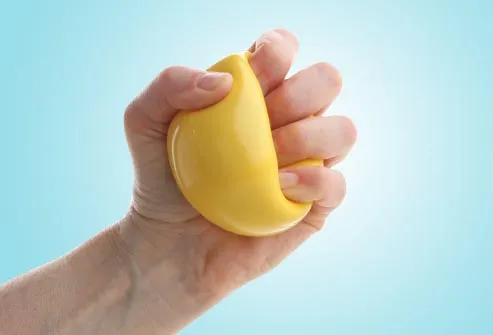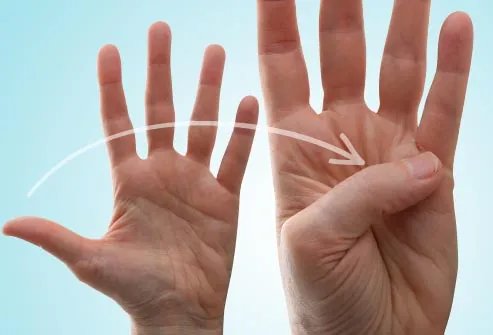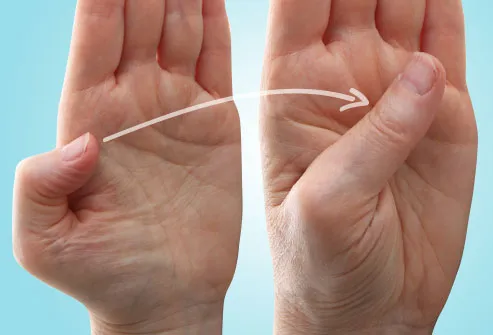Beauty of Hands & Fingers
10 Ways to Exercise Hands and Fingers
Make a Fist
Hand and finger exercises can help strengthen your hands and fingers, increase your range of motion, and give you pain relief. Stretch only until you feel tightness. You shouldn't feel pain. Start with this simple stretch:- Make a gentle fist, wrapping your thumb across your fingers.
- Hold for 30 to 60 seconds. Release and spread your fingers wide.
- Repeat with both hands at least four times.
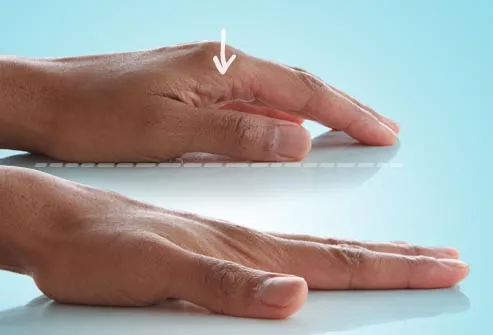
Finger Stretch
Try this stretch to help with pain relief and to improve the range of motion in your hands:- Place your hand palm-down on a table or other flat surface.
- Gently straighten your fingers as flat as you can against the surface without forcing your joints.
- Hold for 30 to 60 seconds and then release.
- Repeat at least four times with each hand.
Claw Stretch
This stretch helps improve the range of motion in your fingers.- Hold your hand out in front of you, palm facing you.
- Bend your fingertips down to touch the base of each finger joint. Your hand should look a little like a claw.
- Hold for 30 to 60 seconds and release. Repeat at least four times on each hand.
Grip Strengthener
This exercise can make it easier to open door knobs and hold things without dropping them.- Hold a soft ball in your palm and squeeze it as hard as you can.
- Hold for a few seconds and release.
- Repeat 10 to 15 times on each hand. Do this exercise two to three times a week, but rest your hands for 48 hours in between sessions. Don't do this exercise if your thumb joint is damaged.
Pinch Strengthener
This exercise helps strengthen the muscles of your fingers and thumb. It can help you turn keys, open food packages, and use the gas pump more easily.- Pinch a soft foam ball or some putty between the tips of your fingers and your thumb.
- Hold for 30 to 60 seconds.
- Repeat 10 to 15 times on both hands. Do this exercise two to three times a week, but rest your hands for 48 hours in between sessions. Don't do this exercise if your thumb joint is damaged.

Finger Lift
Use this exercise to help increase the range of motion and flexibility in your fingers.- Place your hand flat, palm down, on a table or other surface.
- Gently lift one finger at a time off of the table and then lower it.
- You can also lift all your fingers and thumb at once, and then lower.
- Repeat eight to 12 times on each hand.

Thumb Extension
Strengthening the muscles of your thumbs can help you grab and lift heavy things like cans and bottles.- Put your hand flat on a table. Wrap a rubber band around your hand at the base of your finger joints.
- Gently move your thumb away from your fingers as far as you can.
- Hold for 30 to 60 seconds and release.
- Repeat 10 to 15 times with both hands. You can do this exercise two to three times a week, but rest your hands for 48 hours in between sessions.
Thumb Flex
This exercise helps increase the range of motion in your thumbs.- Start with your hand out in front of you, palm up.
- Extend your thumb away from your other fingers as far as you can. Then bend your thumb across your palm so it touches the base of your small finger.
- Hold for 30 to 60 seconds.
- Repeat at least four times with both thumbs.
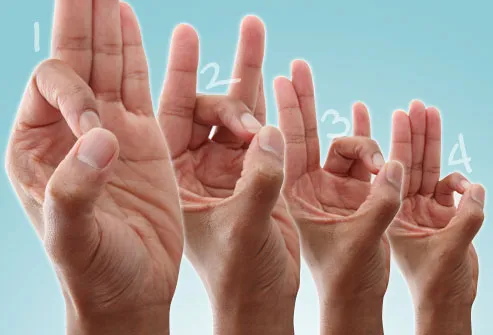
Thumb Touch
This exercise helps increase the range of motion in your thumbs, which helps with activities like picking up your toothbrush, fork and spoon, and pens when you write.- Hold your hand out in front of you, with your wrist straight.
- Gently touch your thumb to each of your four fingertips, one at a time, making the shape of an "O."
- Hold each stretch for 30 to 60 seconds. Repeat at least four times on each hand.
Thumb Stretches
Try these two stretches for your thumb joints:- Hold your hand out, palm facing you. Gently bend the tip of your thumb down toward the base of your index finger. Hold for 30 to 60 seconds. Release and repeat four times.
- Hold your hand out, palm facing you. Gently stretch your thumb across your palm using just your lower thumb joint. Hold for 30 to 60 seconds. Release and repeat four times.
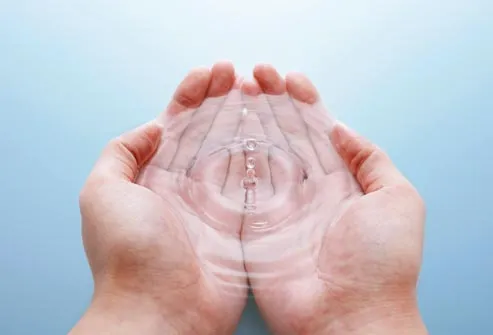
An Exercise Tip
If your hands and fingers feel painful and stiff, try warming them up before you exercise. This can make it easier to move and stretch. Use a heating pad or soak them in warm water for about five to 10 minutes. Or, for a deeper warmth, rub some oil on your hands, put on a pair of rubber gloves, and then soak them in warm water for a few minutes.
Play With Clay
Playing with putty or clay is a great way to increase the range of motion in your fingers and strengthen your hands at the same time. And it won't even feel like exercise. Just follow the kids' lead -- squish the clay into a ball, roll it into long "snakes" with your palms, or use your fingertips to pinch spikes on a dinosaur.Self-Treatment for Hand and Wrist Pain, Finger Pain, Knuckle Pain, Thumb Pain, Stiff Fingers, Swollen Fingers, Writer’s Cramp, Numbness, Tingling, Burning
These extremely common problems in the fingers, hands, knuckles, thumbs, and wrists are most often caused by myofascial trigger points, tiny contraction knots in overworked or traumatized muscles. This comes from decades of research of Doctors Janet Travell and David Simons, authors of the widely acclaimed medical textbook, Myofascial Pain and Dysfunction: The Trigger Point Manual.
Mistaken Diagnoses
The trouble with having pain, numbness, tingling, stiffness, burning, or swelling in your wrists, hands, fingers, and thumbs is that it will be too quickly labeled arthritis, bursitis, tendinitis, carpal tunnel syndrome, or peripheral neuropathy. Too often, say Travell and Simons, these are mistaken diagnoses.Pain Referral
It may surprise you to learn that these abnormal sensations rarely originate in the fingers and hands but are almost always the effects of trigger points in muscles of the neck, chest, upper back, shoulders, upper arms, and forearms. This is called “referred pain.” Trigger points typically send their pain elsewhere.Conventional Therapies
Because of this displacement of symptoms, treating the wrists and hands with magnets, wrist splints, pressure straps, electro-stimulation, ultrasound, and acupuncture is likely to give only temporary relief at best.Painkillers, of course, only mask symptoms and never address the cause. The benefits of pain medication are felt only while the drug is in your system. It goes without saying that surgery is entirely inappropriate when trigger points are the cause of the problem.
Wrist and Hand Pain
You can understand why conventional medical practice can be so off the mark and ineffective if you know some of the basic facts about referred myofascial pain.For example, wrist pain, which makes you feel like you have a wrist sprain, very often comes from trigger points in extensor carpi ulnaris or flexor carpi ulnaris muscles of the forearm.
Finger pain, thumb pain, and pain in the web of the thumb can also come from muscles of the forearm, although it’s not uncommon to trace the trouble to more distant muscles in the shoulder, neck, and upper arm.
Stiff Fingers and “Arthritis”
One of Travell and Simons' more profound discoveries was that trigger points in the extensor digitorum, a forearm muscle that operates the fingers, are the prime cause of stiff fingers.These same trigger points contribute to the pain of tennis elbow and send pain to the second knuckles of the third and fourth fingers. Knuckle pain referred from this muscle feels just like the pain of arthritis. You may have believed for years that you suffer from arthritis and it simply may not be true.
Writer’s Cramp
Sometimes, the hand muscles themselves can be the unrecognized source of problems in the hand. Writer’s cramp, for instance, is caused by trigger points in certain thumb muscles and the tiny interosseous muscles between the bones of the hand.Heberden’s Nodes
Heberden’s nodes, bumps on the sides of the last knuckles, also originate with trigger points in overused interosseous muscles. It is possible to eliminate Heberden’s nodes with trigger point therapy if intervention comes early enough.Even if fully developed, nodes can often be reduced. Travell and Simons believe that the same stresses in the interosseous muscles that create nodes on the knuckles may promote the development of genuine arthritis in the finger joints.
Self-Treatment
When trigger points are the source of the problem, they must be addressed directly and specifically to have any real and lasting effect. Unfortunately, few doctors have taken the time to study Travell and Simons. Most physicians are still basically uninformed about trigger points and aren't equipped to treat them. But don't be dismayed. Trigger point therapy is something you can do for yourself. In The Trigger Point Therapy Workbook, nationally certified
massage therapist Clair Davies has simplified Travell and Simons's
monumental work on trigger points and made it accessible to the layman.
In The Trigger Point Therapy Workbook, nationally certified
massage therapist Clair Davies has simplified Travell and Simons's
monumental work on trigger points and made it accessible to the layman.His innovative methods of self-applied trigger point massage will get rid of pain, numbness, tingling, stiffness, burning, and swelling in wrists, hands, and fingers when trigger points are the cause.
To find out more about the book and the method, please visit the homepage. To read a growing number of reviews by people who have been helped by the book, take a look at the book’s page at Amazon.com.
Tennis Elbow, Elbow Tendinitis

The illustration shows trigger points in the extensor carpi radialis longus muscle. These are the most common cause of pain in the outer elbow, commonly called tennis elbow, elbow tendinitis, or lateral epicondylitis. Trigger points in other forearm muscles cause numbness, tingling, burning, swelling, weakness and stiffness in the wrists, hands and fingers:


Subscribe to:
Comments (Atom)




